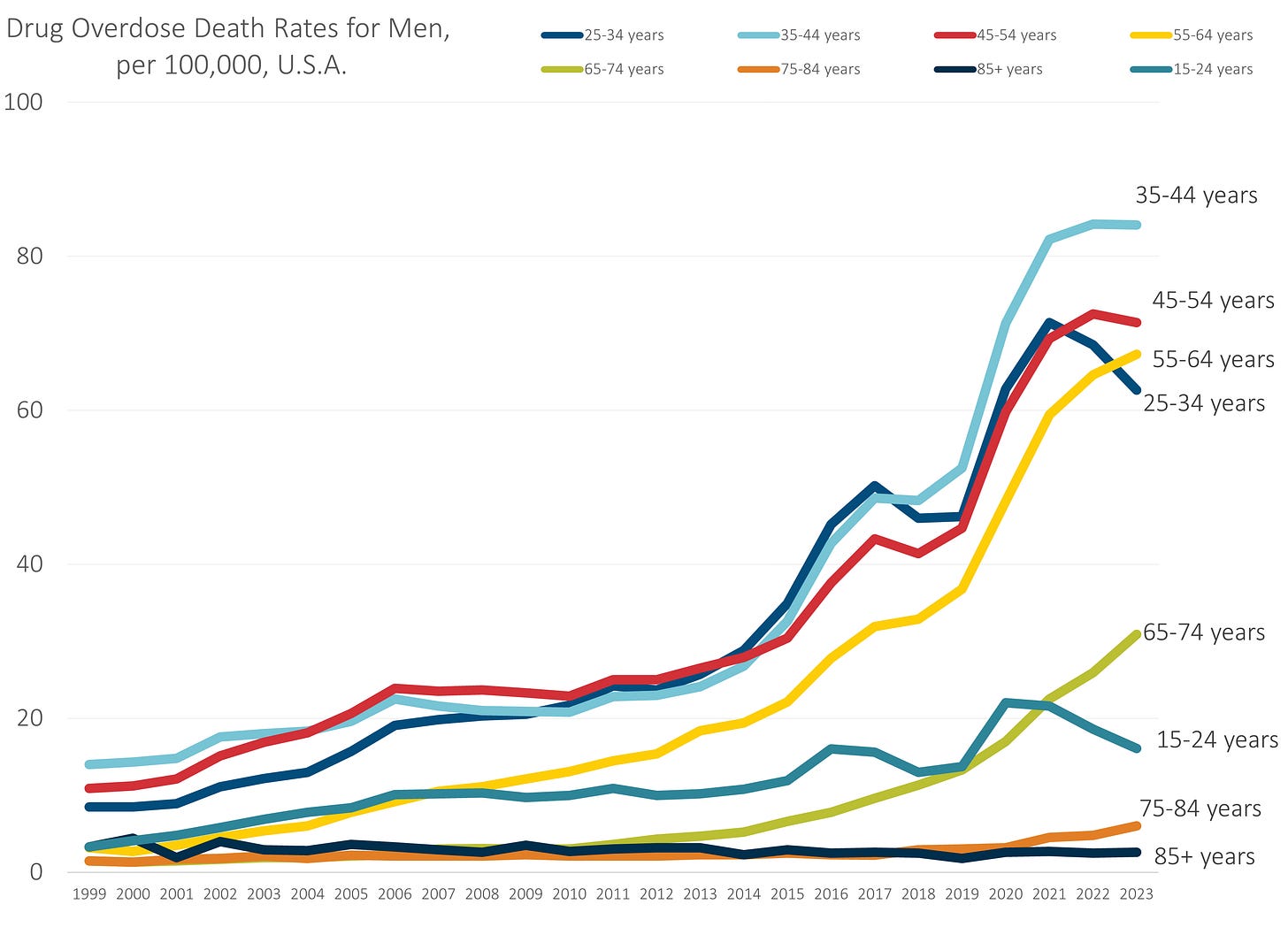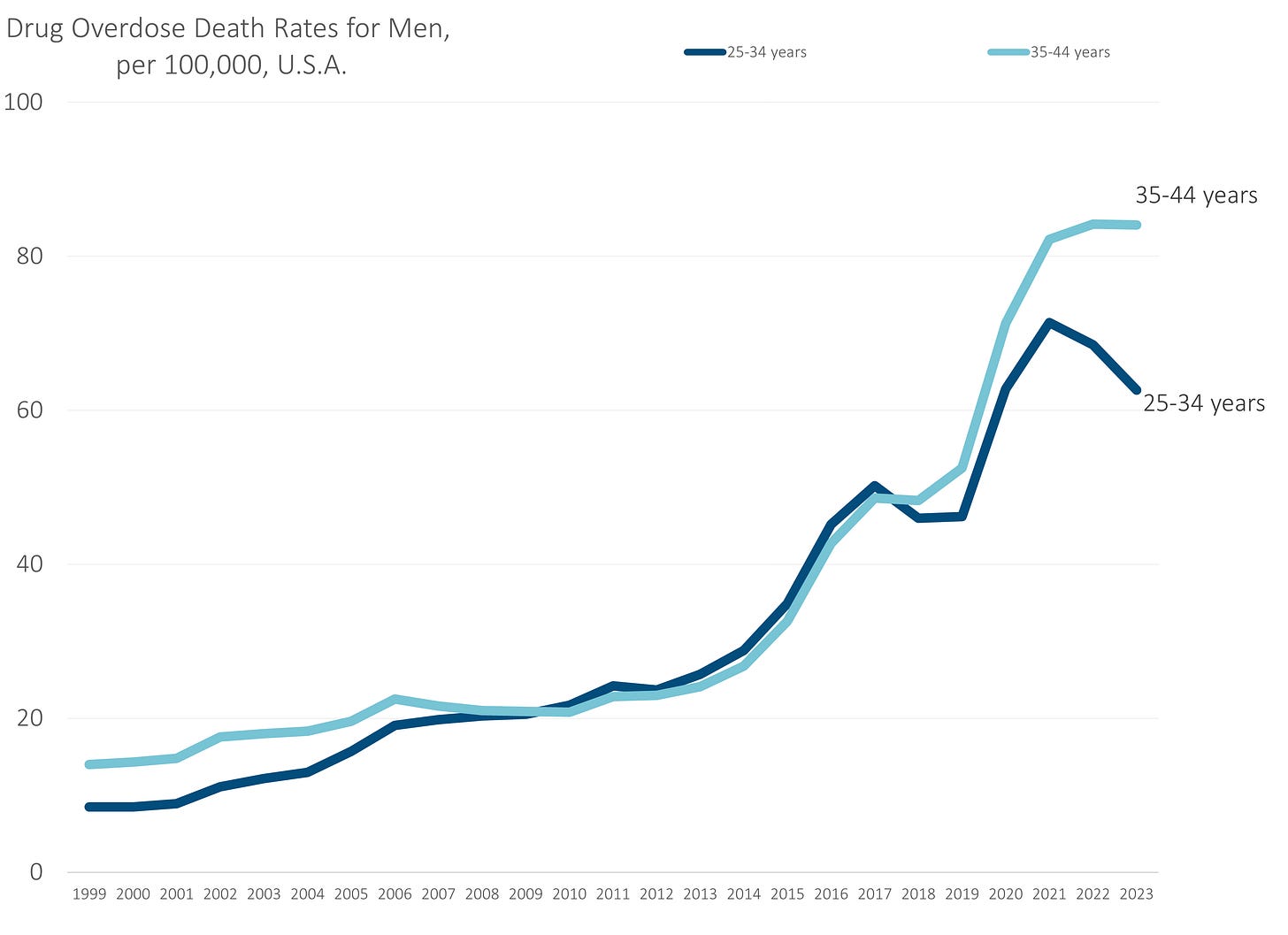Movember 2024: Men and Drug Overdose Deaths
You may have heard OD deaths improved in 2023 -- they're still extremely high
While my main cause for doing direct fundraising for Movember has been my late husband Stuart, men’s mental health has been a big part as well.
Part of this has been the huge increase in drug overdose deaths.
But first…
Movember 2024 Fundraiser
Here are the places you can donate to the Movember Foundation, which supports men’s health, specifically focusing on prostate cancer, testicular cancer, and men’s mental health:
Mary Pat Campbell’s MoSpace – a place to donate at Movember itself
My Movember Facebook fundraiser – my officially linked fundraiser, if this works better for you
And here’s a QR code if that works better for you:
Back to the stats…
Sex Gap in Drug Overdose Deaths, 1999-2023, U.S.
First, the drug overdose deaths issue has cut across the entire U.S. population, at all income levels, both sexes, and all races/ethnicities. It’s not just a matter of mental health, but also issues of poorly-treated chronic pain (having chronic nerve pain myself, I completely understand the temptations and the lack of good choices.)
That said, far more men than women die from drug overdoses:
If I did this as a ratio between the two sexes, twenty years ago, in 2004, the age-adjusted death rate for males in the U.S. for drug ODs, was 2x that of females.
In 2023, it was 2.6x.
It got much worse around 2015-2016, around the time fentanyl flooded illicit drug supplies. Fentanyl has been used as a legal anesthetic (in procedures such as colonoscopies, at much lower doses than used when people OD), but has been involved in some pretty hideous situations. You can do your own news searches.
Things got much worse during the pandemic.
Age profile of trend, 1999-2023, U.S. males
Let me give you the larger period graph first, with all the age groups.
There are some really funky trends going on here, and I want to break them out into some simple groups.
I will not be addressing the age 75+ group. Their trend is minimal — most of their drug ODs are probably related to accidental prescription drug ODs.
Age 15-24: Teens and Younger Men
This curve has a very bumpy ride, and we may want to think about why that is.
This age group, age 15-24, straddles groups that traditionally are often under a lot of adult supervision (at least for the high school years) and may lose control once they leave for college or other adult activity like employment and living on one’s own… or they may be stuck living with parents or relatives.
There was a huge increase in drug OD deaths from 2019 to 2020 in this group. I put data labels on the graph so you could see how the rate increased, from 13.7 per 100K people up to 22.0 per 100K in 2020.
Lots of nutty things occurred in 2020, as we all know.
In 2023, the rate dropped down to 16.1, still above the 2019 level, but much below the 2020 peak of 22.0.
Age 25 - 44: Younger Men and Men in Early Middle Age
The 35-44 year-old age group has the highest death rates from drug overdoses.
There was a huge increase in drug OD deaths… and it’s stayed elevated. Unlike the teens/young men and the younger men group (age 25-34), which saw an improvement in death rates from drug ODs, this one is not showing improvement.
Age 45-74: Middle Age Men into Old Age
These are lower levels than the peak levels seen with the 35-44 year-old age group.
However, they are showing awful trends.
While the death rates are lower, the annual growth rates shown by both the 55-64 year-olds and the 65-74-year-olds are much worse than other age groups.
CAGR = Compound Annual Growth Rate
These are the growth rates covering 2003 - 2023, showing that the age group 65-74 has far exceeded that of the younger groups.
These are not good.
That said, note that the oldest age group here is not really responsive to the pandemic, but is continuing a relatively smooth trend — this may be reflecting underlying health issues, and perhaps overdoses related to prescription drug use.












There probably a lot of pain relief related OD in the all the 45+brackets. Older workers getting hurt or trying to keep working using pain killers.